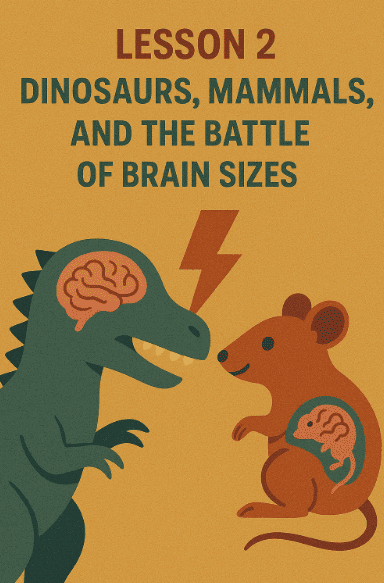
In Lesson 1, we traveled back hundreds of millions of years to see how nervous systems appeared long before true brains.
We met creatures like sponges (no nerves), jellyfish (nerve nets), and worms (nerve cords with ganglia).
We discovered that reflexes came first, and true thinking developed later when animals needed to adapt and survive in more complex environments.
Now, we leap forward in time ⏳ to a world filled with giant dinosaurs, tiny mammals hiding in the shadows, and the ultimate question: Does having a bigger brain always mean being smarter?
The Rise of the Reptile Brains 🦎
After early fish developed small but organized brains, some of their descendants crawled onto land. These early reptiles had brains that were still pretty basic compared to ours.
A reptile brain was mainly focused on survival:
-
Smell – to detect food or danger.
-
Vision – to spot predators or prey.
-
Movement control – to run, crawl, or hunt.
This kind of brain is sometimes called the “reptilian brain.” It handles instinctive actions like aggression, hunting, and basic survival—but not much creativity or complex thinking.
Dinosaurs: Big Bodies, Small Brains 🦖
Dinosaurs ruled the Earth for over 150 million years. Some of them were enormous—long-necked giants like Brachiosaurus, or terrifying hunters like Tyrannosaurus rex.
But here’s the surprise: most dinosaurs had very small brains compared to their body size.
For example:
-
A Stegosaurus, which was about 9 meters long, had a brain the size of a walnut 🥜.
-
A T. rex had a brain the size of a banana 🍌—bigger than Stegosaurus, but still tiny compared to its huge body.
This didn’t mean dinosaurs were “dumb.” They were well-adapted hunters and survivors. But their brains were mostly for instinct: chase prey, eat food, escape danger. They weren’t painting pictures or solving puzzles.
Mammals Enter the Stage 🐀🦢
While dinosaurs were stomping around, another group of animals lived quietly in the shadows: early mammals. These were small, furry, mostly nocturnal (active at night) creatures that looked like shrews or rats.
Their brains, though much smaller in absolute size than dinosaurs’, had a special advantage:
-
Mammals had a neocortex—a newer, wrinkled outer layer of the brain.
The neocortex allowed mammals to:
-
Process complex information.
-
Develop better memory.
-
Learn new behaviors quickly.
So even though a mammal’s brain was smaller, it was more powerful gram for gram than a dinosaur brain.
This set up an evolutionary “battle” of brain strategies:
-
Dinosaurs = giant bodies, relatively small brains, instinct-based survival.
-
Mammals = small bodies, but bigger brain-to-body ratios and flexible intelligence.
Brain Size vs. Body Size: The Encephalization Quotient 🧠📏
Scientists realized that measuring absolute brain size is misleading. A whale has a brain that weighs over 6 kilograms, but that doesn’t automatically make it smarter than a human.
So, they use a measure called the Encephalization Quotient (EQ).
EQ = brain size compared to body size, adjusted for expected values.
-
Dinosaurs often had very low EQs (tiny brains for their size).
-
Early mammals had higher EQs.
-
Humans have one of the highest EQs of all animals (but not the highest).
This is why a small mammal could outsmart a giant dinosaur in certain situations—because the efficiency and complexity of the brain mattered more than raw size.
The Fall of Dinosaurs, the Rise of Mammals 🌍🔥
About 66 million years ago, a catastrophic asteroid hit Earth. Dust and firestorms changed the climate, killing off most of the dinosaurs.
Mammals, however, survived. Why?
-
Their flexible brains allowed them to adapt to new foods and changing environments.
-
They reproduced quickly compared to giant reptiles.
-
Their nocturnal lifestyle protected them from some dangers.
With dinosaurs gone, mammals spread and diversified into new forms: primates, bats, whales, and eventually us humans.
This moment in history shows us that brain adaptability beats brute size.
Storytime: The Clever Mammal vs. The Giant Dinosaur 🐀 vs 🦖
Imagine a scene 70 million years ago. A massive T. rex prowls through the forest, its powerful legs shaking the ground. Nearby, a small mammal—something like an early opossum—scurries through the underbrush.
The dinosaur doesn’t even notice it.
Why?
Because the mammal hides, waits, and moves silently in the dark. Its brain lets it remember where food is hidden. It can even teach its young by example.
The T. rex, with its banana-sized brain, is an incredible hunter—but it’s not built for subtlety, planning, or flexible problem-solving.
When disaster struck (the asteroid), who had the better long-term survival advantage? The clever mammal.
Mammalian Brain Specialties 🐒
As mammals evolved further, different groups developed special brain powers:
-
Primates (monkeys, apes, humans): Expanded neocortex for vision, memory, and social interaction.
-
Bats: Specialized brain areas for echolocation (using sound to “see”).
-
Whales and dolphins: Large brains for complex communication and social structures.
Brains were no longer just survival engines. They were becoming centers for social behavior, communication, and even play.
The Key Lesson: Brains Are About Adaptability, Not Size 🗝️
The story of dinosaurs and mammals teaches us something important:
-
A big body with a small brain can survive for millions of years if the environment is stable.
-
But when the world changes, it’s the adaptable, flexible brains that win.
This explains why mammals eventually replaced dinosaurs as the dominant land animals and why human intelligence became possible.
Key Takeaways 🌟
-
Dinosaurs had relatively small brains compared to their massive bodies.
-
Mammals, though small, had more advanced brains with a neocortex.
-
Brain-to-body ratio (EQ) is a better measure of intelligence than raw size.
-
Mammals survived the mass extinction because of adaptability.
-
Evolution favors brains that can learn, remember, and adapt—not just brains that control instinct.